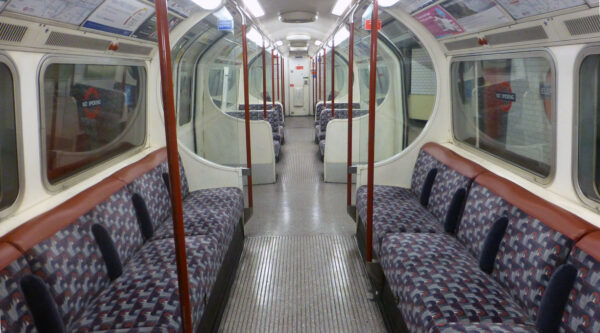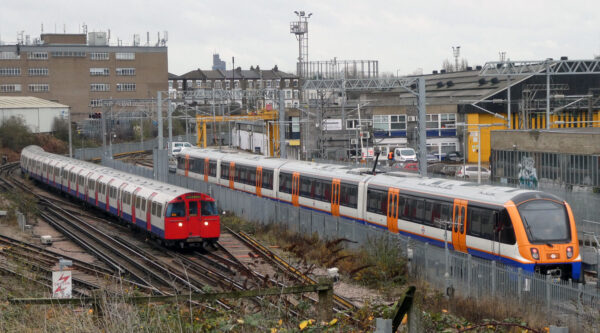Sunday marks the 50th anniversary of the Bakerloo line trains on the London Underground. Introduced on 26th June 1972, they’re also now the oldest electric multiple units (EMU) in use anywhere in the UK.
The trains have a bit of a complicated history — because this is the London Underground and nothing is ever simple. And the Bakerloo line trains owe their existence to, of all things, the extension of the Piccadilly line to Heathrow Airport in the 1970s.
In the early 1970s, both the Northern and Bakerloo line trains were pretty much at the end of their life and needed replacing, and a plan was agreed to order a fleet of new trains, initially for the Northern line, and then the Bakerloo. However, along came the Piccadilly line extension, and that required a whole new fleet of trains to replace their 1959-era trains.
As the ex-Piccadilly line trains were only 20 years old rather than scrapping them, it was decided to transfer them to the Northern line. So the Piccadilly line was to get a load of new trains as well as several new stations, while the Northern line — nicknamed the “Misery Line” — expecting a fleet of new trains, got a load of second-hand trains instead.
However, the Piccadilly line only had 76 trains to give to the Northern, leaving a shortfall of around 30 trains. To fill the gap, in July 1970 it was announced that a fleet of 30 new trains would be made for the Northern line. As the Northern line contract was a bit of a rush job, they took the existing 1967-era Victoria line trains as the base design and modifed that instead.
Three-quarters of the cost of the new Piccadilly and Northern line trains was picked up by the central government, and the rest paid for by the GLC.
The first of the new trains entered passenger service on 26th June 1972 — 50 years ago, and were nicknamed the Silver Trains thanks to their unpainted aluminium train carriages.
Another 33 trains had already been ordered — known as Mark 2s — arriving later in 1972, but in 1977, they were transferred to the Bakerloo line to replace its increasingly unreliable and very elderly 1938-era trains.
For a while, the old and older trains ran side by side on the Bakerloo line, but when the Jubilee line opened, taking over part of the Bakerloo line that ran up to Stanmore, that meant the shorter Bakerloo line needed fewer trains and all the remaining 1938-era trains were taken out of service.
Ever since then though, the Bakerloo line has run using these increasingly ageing 1972 era trains, which are themselves based on the even older 1967 design.
(some 1972 trains ended up elsewhere, but have since been scrapped)
The trains were given a major refurbishment following the King’s Cross fire to bring them up to revised safety standards with brighter lighting and more fire-resistant furnishings, but also to add in modern extras, such as the automatic station announcement tannoys. It was then that they also gained their current livery, with white and blue exteriors with red doors. The trains received another refurbishment that started in 2014 mainly to keep the elderly trains running, so works were mainly replacing worn out components and parts of the trains that were starting to rust and suffer metal fatigue.
Ever since then, the trains have managed to limp on, getting occasional repairs when more metal fatigue is found during routine maintenance inspections.
There is a plan to replace them, using the design that’s been approved for the new Piccadilly line trains — but the current funding situation has delayed that until an unknown point in the future.
So, the UK’s oldest EMU trains still in passenger service are likely to have to keep serving London Underground passengers for another decade, or longer.









Very bold move to say oldest EMUs in the world; I would say the Portugal CP Class 3150 were older being built from the late ’50’s and refurbed 20 years back
I didn’t say they are the oldest EMUs in the world.
Do the Volks trains in Brighton not count as EMUs, and if not, why not?
Ah correct no you didn’t, I misread that
I have slight mobility problems due to arthritis and usually haul myself up into a train using the handle behind the sliding door.
But as Ian’s picture shows, these trains don’t have a handle.
At least though the journey, where I tend to use the Bakerloo Line most, which is to Paddington, has now been replaced by the Lizzie Line, which has excellent boarding.
Could we have handles on the Bakerloo Line please?
1972 Stock are having LED lights; internal destination displays; wheelchair bays; long floor/ceiling handrails by some doors; fitted in a continuing refurbishment
They don’t have arm rests either, I think for the same reason the Central Line ones don’t – people kept breaking them off. Funny, I hardly ever use the Bakerloo – it just doesn’t go where I want to go, and when it does the dour decor and places it passes through in NW London tend to depress..
Traditionally I would use the Bakerloo from Paddington to Baker Street to get the Jubilee, or to Oxford Circus for the Victoria or Central, or Piccadilly Circus for the Piccadilly.
The Circle/H&C might be more comfortable to Baker Street or Kings Cross but the trains are less frequent, and the H&C station at Paddington is a lot further away. Changing at Edgware Road (Circle) is annoying.
I have used the Bakerloo from Paddington to Marylebone, but to be honest that one is walkable in about 20 minutes.
Once the Bond Street Elizabeth Line station opens, I’ll be using that to get onto the Jubilee, or just stay on to Canary Wharf or Stratford, depending on what I’m doing. The Elizabeth Line doesn’t intersect with the Victoria or Piccadilly, but I might end up using the Northern or Central more than I used to. Or even Thameslink!
The Bakerloo line trains also manually operated, rather than fully automatic like all other London Underground trains now. Apparently this is because the signalling system on the National Rail section of the Watford line is not yet fully automated. A tube train driver told me it gave him more job satisfaction to drive a Bakerloo line train than any other tube train, as it involves a higher degree of driver skill and judgement.
Piccadilly Line is also manual operation